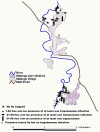Identification of different trypanosome species in the mid-guts of tsetse flies of the Malanga (Kimpese) sleeping sickness focus of the Democratic Republic of Congo
- PMID: 22992486
- PMCID: PMC3468371
- DOI: 10.1186/1756-3305-5-201
Identification of different trypanosome species in the mid-guts of tsetse flies of the Malanga (Kimpese) sleeping sickness focus of the Democratic Republic of Congo
Abstract
Background: The Malanga sleeping sickness focus of the Democratic Republic of Congo has shown an epidemic evolution of disease during the last century. However, following case detection and treatment, the prevalence of the disease decreased considerably. No active survey has been undertaken in this focus for a couple of years. To understand the current epidemiological status of sleeping sickness as well as the animal African trypanosomiasis in the Malanga focus, we undertook the identification of tsetse blood meals as well as different trypanosome species in flies trapped in this focus.
Methods: Pyramidal traps were use to trap tsetse flies. All flies caught were identified and live flies were dissected and their mid-guts collected. Fly mid-gut was used for the molecular identification of the blood meal source, as well as for the presence of different trypanosome species.
Results: About 949 Glossina palpalis palpalis were trapped; 296 (31.2%) of which were dissected, 60 (20.3%) blood meals collected and 57 (19.3%) trypanosome infections identified. The infection rates were 13.4%, 5.1%, 3.5% and 0.4% for Trypanosoma congolense savannah type, Trypanosoma brucei s.l., Trypanosoma congolense forest type and Trypanosoma vivax, respectively. Three mixed infections including Trypanosoma brucei s.l. and Trypanosoma congolense savannah type, and one mixed infection of Trypanosoma vivax and Trypanosoma congolense savannah type were identified. Eleven Trypanosoma brucei gambiense infections were identified; indicating an active circulation of this trypanosome subspecies. Of all the identified blood meals, about 58.3% were identified as being taken on pigs, while 33.3% and 8.3% were from man and other mammals, respectively.
Conclusion: The presence of Trypanosoma brucei in tsetse mid-guts associated with human blood meals is indicative of an active transmission of this parasite between tsetse and man. The considerable number of pig blood meals combined with the circulation of Trypanosoma brucei gambiense in this focus suggests a transmission cycle involving humans and domestic animals and could hamper eradication strategies. The various species of trypanosomes identified in the Malanga sleeping sickness focus indicates the coexistence of animal and human African Trypanosomiasis. The development of new strategies integrating control measures for human and animal trypanosomiasis may enable the reduction of the control costs in this locality.
Figures



Similar articles
-
Trypanosome infection rates in tsetse flies in the "silent" sleeping sickness focus of Bafia in the Centre Region in Cameroon.Parasit Vectors. 2015 Oct 12;8:528. doi: 10.1186/s13071-015-1156-z. Parasit Vectors. 2015. PMID: 26458386 Free PMC article.
-
Molecular identification of different trypanosome species and subspecies in tsetse flies of northern Nigeria.Parasit Vectors. 2016 May 23;9(1):301. doi: 10.1186/s13071-016-1585-3. Parasit Vectors. 2016. PMID: 27216812 Free PMC article.
-
Detection and identification of pathogenic trypanosome species in tsetse flies along the Comoé River in Côte d'Ivoire.Parasite. 2015;22:18. doi: 10.1051/parasite/2015018. Epub 2015 Jun 2. Parasite. 2015. PMID: 26035296 Free PMC article.
-
The origins of the trypanosome genome strains Trypanosoma brucei brucei TREU 927, T. b. gambiense DAL 972, T. vivax Y486 and T. congolense IL3000.Parasit Vectors. 2012 Apr 7;5:71. doi: 10.1186/1756-3305-5-71. Parasit Vectors. 2012. PMID: 22483376 Free PMC article. Review.
-
[Value of molecular biology in the identification of trypanosomes responsible for African trypanosomiasis or sleeping sickness].Med Trop (Mars). 2000;60(2):115-9. Med Trop (Mars). 2000. PMID: 11100432 Review. French. No abstract available.
Cited by
-
Free-ranging pigs identified as a multi-reservoir of Trypanosoma brucei and Trypanosoma congolense in the Vavoua area, a historical sleeping sickness focus of Côte d'Ivoire.PLoS Negl Trop Dis. 2021 Dec 22;15(12):e0010036. doi: 10.1371/journal.pntd.0010036. eCollection 2021 Dec. PLoS Negl Trop Dis. 2021. PMID: 34937054 Free PMC article.
-
Wolbachia, Sodalis and trypanosome co-infections in natural populations of Glossina austeni and Glossina pallidipes.Parasit Vectors. 2013 Aug 8;6(1):232. doi: 10.1186/1756-3305-6-232. Parasit Vectors. 2013. PMID: 23924682 Free PMC article.
-
Domestic pigs as potential reservoirs of human and animal trypanosomiasis in Northern Tanzania.Parasit Vectors. 2013 Nov 9;6(1):322. doi: 10.1186/1756-3305-6-322. Parasit Vectors. 2013. PMID: 24499540 Free PMC article.
-
Trypanosome infection rates in tsetse flies in the "silent" sleeping sickness focus of Bafia in the Centre Region in Cameroon.Parasit Vectors. 2015 Oct 12;8:528. doi: 10.1186/s13071-015-1156-z. Parasit Vectors. 2015. PMID: 26458386 Free PMC article.
-
A scoping review on tsetse fly blood meal sources and its assay methods since 1956 to 2022.Parasit Vectors. 2024 Feb 2;17(1):52. doi: 10.1186/s13071-023-06114-3. Parasit Vectors. 2024. PMID: 38308365 Free PMC article.
References
-
- Penchenier L, Wang S, Bureau P. Historique et évolution de la maladie du sommeil dans les pays de l’OCEAC. In La trypanosomiase dans les états de l’OCEAC : historique et actualité. Bul Liais Doc OCEAC. 1996;29:11–22.
Publication types
MeSH terms
Substances
LinkOut - more resources
Full Text Sources

